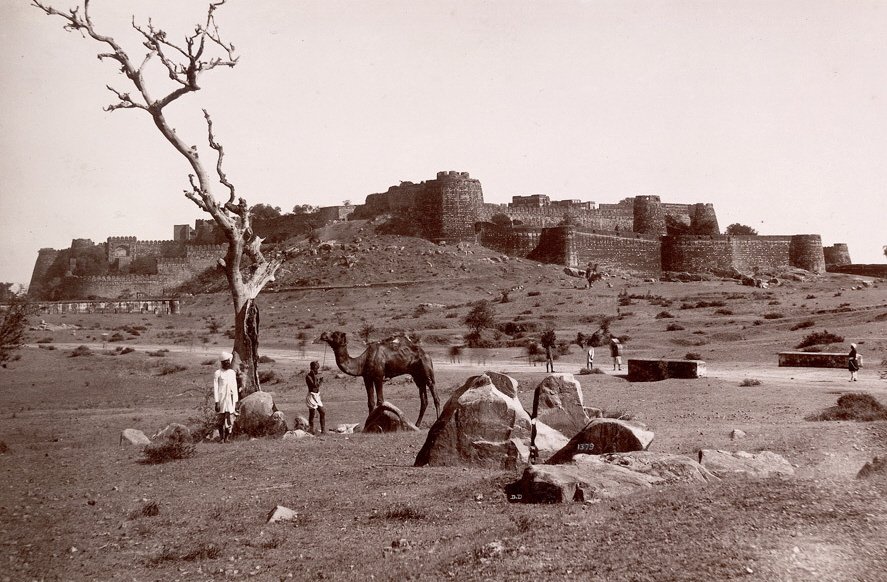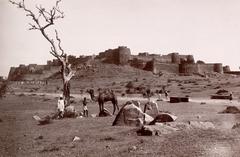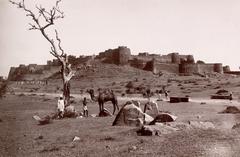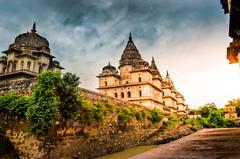
Visiting Jhansi Fort: Hours, Tickets, and Historical Insights
Date: 17/07/2024
Introduction
Nestled in the heart of Jhansi, Uttar Pradesh, India, Jhansi Fort stands as a monumental symbol of India’s rich history and cultural heritage. Constructed in the 17th century by Raja Bir Singh Deo of Orchha, this massive fort has witnessed numerous historical events and has played a pivotal role in the country’s fight against colonial rule. Jhansi Fort is particularly renowned for its association with Rani Lakshmibai, a key figure in the Indian Rebellion of 1857, who led her troops from this very stronghold against the British East India Company (source).
Strategically perched on a rocky hill known as Bangira, the fort offers breathtaking views of the surrounding plains and the Betwa River. Its robust architecture, characterized by thick stone walls, bastions, and intricate carvings, reflects the Bundela and Maratha styles of construction. Over the centuries, the fort has undergone several transformations, especially under Maratha influence, making it a fascinating site for both history enthusiasts and casual travelers alike (source).
Today, Jhansi Fort is not just a relic of the past but a vibrant cultural hub, hosting annual festivals like the Jhansi Mahotsav, which celebrates the region’s heritage through music, dance, and art. The fort also features a museum that houses artifacts from various periods, offering a comprehensive glimpse into the historical and cultural tapestry of Jhansi (source).
Table of Contents
- Introduction
- Historical Background of Jhansi Fort
- Architectural Features
- Cultural Significance
- Preservation and Conservation
- Visitor Information
- Nearby Attractions
- FAQ
- Conclusion
Historical Background of Jhansi Fort
Early History and Construction
Jhansi Fort’s construction dates back to the 17th century, around 1613, under the reign of Raja Bir Singh Deo of Orchha. Raja Bir Singh Deo, a Bundela Rajput chief, was a close ally of Mughal Emperor Jahangir. Strategically built on a rocky hill called Bangira, the fort provides a vantage point over the surrounding plains and the Betwa River. Its architecture reflects the Bundela style, characterized by robust walls, bastions, and intricate carvings.
Maratha Influence
In the early 18th century, the fort came under Maratha control. In 1729, Maratha general Peshwa Baji Rao I appointed Naru Shankar as the Subedar of Jhansi. Naru Shankar made significant contributions to the fort’s structure, including the Shankar Garh bastion. The Marathas fortified the fort further, adding several new structures and enhancing its defenses. The fort became a crucial military outpost for the Marathas, serving as a base for their operations in northern India.
The British East India Company and the Sepoy Mutiny
The British East India Company annexed Jhansi in 1853 under the Doctrine of Lapse, a policy devised by Lord Dalhousie. This policy allowed the British to annex any princely state without a direct heir, leading to widespread discontent among the local population and ruling class.
In 1857, the Indian Rebellion, also known as the Sepoy Mutiny, broke out. Rani Lakshmibai, the widow of Maharaja Gangadhar Rao, emerged as a key figure in the rebellion. She led the resistance against the British from Jhansi Fort, becoming a symbol of Indian resistance and patriotism. The fort witnessed intense battles during the rebellion, with Rani Lakshmibai displaying extraordinary courage and leadership. Despite her valiant efforts, the British forces eventually recaptured the fort in 1858.
Architectural Features
Jhansi Fort is renowned for its robust architecture and strategic design. The fort covers an area of 15 acres and is surrounded by a massive stone wall with ten gates, including the Khandero Gate, Datia Darwaza, and Unnao Gate. The fort’s walls are interspersed with bastions and watchtowers, providing panoramic views of the surrounding landscape.
Inside the fort, several structures stand out, including the Panch Mahal, a five-storied palace that served as the residence of the ruling family. The fort also houses the Karak Bijli Tank, a large water reservoir, and the Baradari, a pavilion for public gatherings. The Ganesh Mandir, dedicated to Lord Ganesha, is another notable structure within the fort complex.
Cultural Significance
Jhansi Fort holds immense cultural and historical significance in India. It is a symbol of resistance against colonial rule and a testament to Rani Lakshmibai’s bravery. The fort is a popular tourist destination, attracting visitors from across the country and the world. It serves as a reminder of India’s rich history and the enduring spirit of its people.
The fort is also a venue for various cultural events and festivals. The Jhansi Mahotsav, an annual cultural festival, is held within the fort premises, showcasing traditional music, dance, and art forms. The festival celebrates the region’s cultural heritage and attracts artists and performers from different parts of India.
Preservation and Conservation
Efforts have been made to preserve and conserve Jhansi Fort, given its historical and cultural importance. The Archaeological Survey of India (ASI) has undertaken several restoration projects to maintain the fort’s structural integrity and prevent further deterioration. These efforts include repairing damaged walls, restoring historical structures, and improving visitor facilities.
The fort is also part of the Jhansi Heritage Walk, an initiative to promote heritage tourism and raise awareness about the city’s historical landmarks. The walk includes guided tours of the fort, providing visitors with insights into its history, architecture, and cultural significance.
Visitor Information
Opening Hours
Jhansi Fort is open to visitors throughout the year, with the best time to visit being between October and March when the weather is pleasant. The fort’s visiting hours are from 6:00 AM to 6:00 PM.
Ticket Prices
The entry fee for Jhansi Fort is nominal. Indian citizens are charged INR 15, while foreign nationals are charged INR 200. Special discounts are available for students and senior citizens.
How to Get There
Jhansi Fort is easily accessible by road, rail, and air. Jhansi Junction is a major railway station connected to various parts of India. The nearest airport is Gwalior Airport, about 100 km away.
Travel Tips
- Wear comfortable shoes as the fort requires a fair amount of walking.
- Carry water and snacks, although there are vendors inside the fort.
- Hire a guide for a more insightful tour of the fort.
Nearby Attractions
- Rani Mahal: The residence of Rani Lakshmibai, now a museum.
- St. Jude’s Shrine: A famous church in Jhansi.
- Barua Sagar: A town with a picturesque lake and historical significance.
FAQ
Q: What are the visiting hours for Jhansi Fort? A: Jhansi Fort is open from 6:00 AM to 6:00 PM.
Q: How much does it cost to visit Jhansi Fort? A: The entry fee is INR 15 for Indian citizens and INR 200 for foreign nationals.
Q: What are the nearby attractions? A: Nearby attractions include Rani Mahal, St. Jude’s Shrine, and Barua Sagar.
Conclusion
Jhansi Fort stands as a testament to India’s resilient spirit and rich historical tapestry. From its strategic construction in the 17th century by Raja Bir Singh Deo to its significant role in the Indian Rebellion of 1857 led by Rani Lakshmibai, the fort encapsulates centuries of history and culture. Today, it serves not only as a historical monument but also as a cultural venue hosting events like the Jhansi Mahotsav, which bring to life the traditions and arts of the region (source).
For visitors, Jhansi Fort offers a comprehensive experience—from exploring its robust architecture and panoramic views to delving into its rich past through guided tours and museum exhibits. Practical information such as visiting hours, ticket prices, and travel tips ensures that every visitor can make the most of their journey. The fort’s preservation efforts by the Archaeological Survey of India (ASI) further enhance its appeal, making it a must-visit destination for anyone interested in India’s historical and cultural heritage (source).
In summary, a visit to Jhansi Fort is a journey through time, offering invaluable insights into India’s past and the enduring spirit of its people. Whether you’re a history buff, a culture enthusiast, or just a curious traveler, Jhansi Fort promises an enriching and unforgettable experience (source).
References
- Explore Jhansi Fort - Visiting Hours, Tickets, and Historical Insights, 2024, Unknown Author (source)
- Explore Jhansi Fort - Visiting Hours, Tickets, and Historical Significance, 2024, Unknown Author (source)
- Jhansi Fort Visitor Guide - Tickets, Timings, History, and Travel Tips, 2024, Unknown Author (source)




